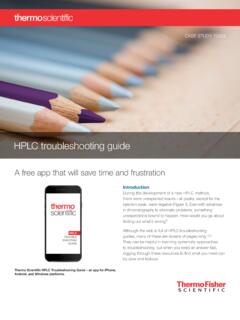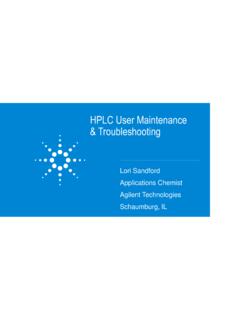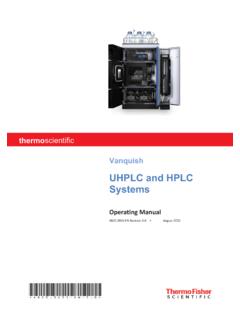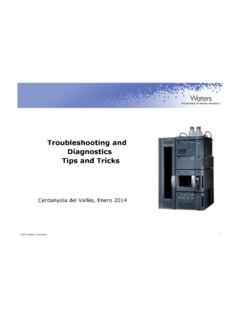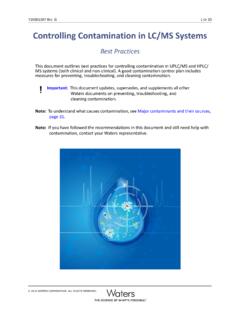Transcription of 3. Troubleshooting for Increased Pressure
1 191I. HPLC ColumnsII. UHPLC ColumnsIV. Related ProductsV. ApplicationsVI. Technical NotesVII. Index III. Preparative Packing Materials3. Troubleshooting for Increased PressureIntroductionRepeated analysis may increase back Pressure . Continuous use of HPLC columns under high Pressure can cause deteri-oration and overload of the equipment. Therefore, it is important to monitor column back Pressure regularly and solve the problem of the Clogging SiteThe back Pressure increase can be due to clogging of a column or clogging of the equipment.
2 First of all, identify theclogging the system components one by one to identify the clogged component(s). Start by disconnecting the column from the system and measure the Pressure of flowing mobile phase. The Pressure should be close to zero. If the flow Pressure without a column is normal, then Pressure increase is due to the clogged column. The cause of clogging needs to be determined and preventative measures implemented. The column may need to be of EquipmentIdentify the specific clogging site according to the method above.
3 (Case 1) High Pressure caused by clogged tubingCause: Salt deposit in : Disconnect the column and any other equipment before pumping water through the tubing. Washing in a reversing direction is also an effective way. If the situation does not improve, replace the tubing with a new one.(Case 2) High Pressure caused by clogged pumpCause: Line filter of pump is : Take apart the line filter, and soak it in the solvent, then clean in an ultrasonic cleaner. If the situation does not improve, replace the line filter with a new one.
4 (Case 3) High Pressure caused by clogged manual injectorCause: Manual injector is : Inject with 20ml of contaminant dissolving solvent ( , methanol) by syringe. Wash both lines in LOAD and INJECT position. Cleaning the injector in an ultrasonic bath is also effective. If solids caused the clogging, wash the injector in a reversing direction. If the situation does not improve, replace the injector with a new Phase Waste SolutionRecorder Schematic Diagram of HPLC 192I. HPLC ColumnsII. UHPLC ColumnsIII. Preparative Packing MaterialsIV.
5 Related ProductsV. ApplicationsVI. Technical NotesVII. Index What should I do when a clogged column caused Pressure increase?(Case 1) Salt deposit in a column caused by pumping high-organic solvent after using buffer solutionCause: Salt deposit in a : Wash columns for 30 minutes at half the normal flow rate using 10% organic solvent (methanol or acetonitrile) in water to dissolve salt deposit. If the situation does not improve, wash the column with 100% water under the same : To switch to high organic solvent concentration after using a buffer, first wash a column with a salt-free mobile phase (with the same concentration of organic solvent as the buffer), then switch to the mobile phase of higher organic concentration.
6 Example : To change mobile phase from 10/90 (v/v) acetonitrile/20mmol/l phosphate buffer ( ) to 90/10 (v/v) acetonitrile/water, first wash the column for 15 minutes with 10/90 (v/v) acetonitrile/water, and then switch to 90/10 (v/v) acetonitrile/water.(Case 2) The sample is not completely dissolved or unfilteredCause: Column frit is clogged by insoluble sample or : Connect the column in the reverse direction and disconnect from the detector, and then wash the column for 30 minutes at half of the usual flow rate with the same mobile phase used for analysis.
7 If the situation does not improve, change the frit in the front end of the column (We can replace end fittings with a paid service fee.). Prevention: We strongly recommend filtering sample and/or mobile phase. For more information, please see page 193, Technical Information 4. Sample Pretreatment for HPLC 1) : If the column is continually connecting in the reverse direction, it may deteriorate.(Case 3) Protein samples that adsorb easily to the column or samples that are slightly soluble in mobile phaseCause: Samples have adsorbed to packing material or deposited in a : Wash the column for 30 minutes with half of the normal flow rate using a solvent that can dissolve the adsorbed substances.
8 Here are washing procedures for each column type. [Reversed phase columns] a) When absorbed substances are not proteins, wash with methanol or tetrahydrofuran. b) When absorbed substances are proteins, wash with 50-70% of acetonitrile/water (containing of trifluoroacetic acid). However, proteins may precipitate in high concentration of organic solvent. [COSMOSIL SL-II] Wash with methanol, tetrahydrofuran or ethanol. [Fullerene columns] Wash with o-dichlorobenzene, 1,2,4-trichlorobenzene. [COSMOSIL Sugar-D/NH2/HILIC columns] Wash with 50/50 (v/v) acetonitrile/water for NH2-MS and 100% water for Sugar-D and HILIC : (a) Choose appropriate pretreatment for each sample.
9 For more information, please see page 193, Technical Information 4. (b) We also recommend using guard columns, please see page 199, Technical Information When wash columns, do not connect column outflow end to the detector. Let the solvent flow into waste. Excessive washing may deteriorate the performance of columns. Do not use strongly alkaline solution (more than pH ) or strongly acidic solution (less than pH ) for silica-base packing material. Store columns in manufacturer recommended storage solvent after washing.
10 If the column performance does not improve after washing, replace the column.(Case 4) Graduate Pressure increase over timeCasue 1: Contamination of column due to normal long-term : Wash the column like (Case 3).Casue 2: Column damage due to normal long-term : Replace the improvement in performance after the column performance has not improved after washing, we recommend replacing the column to lessen Pressure burden on the instrument. You could continue to use the column if peak shape is acceptable and the maximum Pressure is less than 20 Informatio








